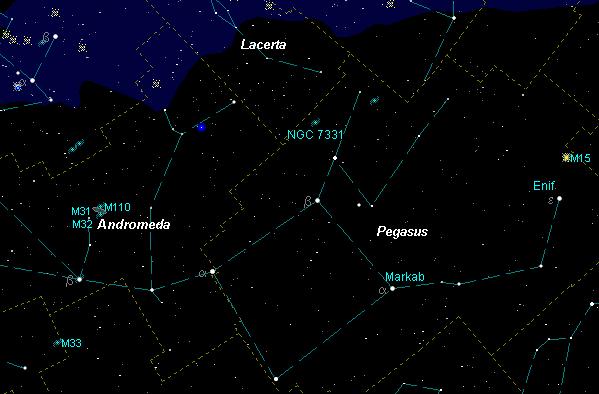The Great Square of Pegasus
Autumn is a fantastic time to enjoy the night sky. With longer night time hours, the lack of mosquitoes and decent temperatures, we can take advantage of late summer and early winter observing. Fall is a great time to locate the many objects of Pegasus. Taking on the appearance of a baseball diamond, the “Great Square” can be seen low in the east.
The magnitude 2.4 star Enif is 670 ly away and represents the nose. It is a spectral type K supergiant star with a surface temperature of 4,460 Kelvin making it cooler than the sun but ten times more massive. If we were to substitute Enif in place of our sun, it would take up forty degrees of sky or the distance between the stars Alkaid (tail end of the Big Dipper) and Polaris (tail end of the Little Dipper). Enif is fusing helium into carbon and oxygen indicating it is at the end of its life.
Not far from Enif is the only globular cluster in this constellation. M15 is a wonderful magnitude 6.2 object and is a nicely resolved and a must for your next observing session. At a distance of 33,600 ly, it appears to measure 175 ly in diameter and takes about half a lunar width of sky. Starting from the star Scheat at the top of the square, move eight and a half degrees further north to NGC 7331. Commonly known as the Deer Lick Galaxy, it measures 10 X 3 arc minutes with a magnitude of 9.5. With an estimated distance of 40 million ly, NGC 7331 is seen with five 15th magnitude remote galaxies off to its left. The Deer Lick is an excellent guide to locate the ever-challenging Stephan’s Quintet. Here we see a group of four galaxies: NGC 7317 and NGC 7318 measuring 280 million ly away, NGC 7319 at 320 million ly away with the foreground galaxy NGC 7320 only 47 million ly away.
The brightest and closest neighbouring galaxy to the Milky Way is located just east of the Great Square. The Andromeda Galaxy aka M31 is a naked eye object from the countryside on a moonless night. From binoculars to large telescopes, the sight of this object is beyond words. Moderate size telescopes will reveal a couple of the galactic arms as well as the star cloud NGC 206, situated at the west end of the main galaxy. M31 also possesses two satellite galaxies called M32 to the west and about 25 arc minutes from NGC 206 as well as M110 to the north of M31’s core.

Both these satellite galaxies are elliptical and glow at magnitude 8.2 and 8.0 respectively. However, since M110’s area is spread out over a wide area – it appears fainter than M32. The parent galaxy possesses many globular clusters with observers with a large telescope can see.
The planet Venus can be glimpsed low in the western sky as it emerges from the solar glare. It will climb higher each night into April 2020. We still have a few hours each night to enjoy brilliant Jupiter that sets before 10 p.m. local time at the beginning of the month and fainter Saturn setting a couple of hours later.
Two years ago, news broke that our solar system had received an interstellar visitor Oumuamua and was the strangest object ever discovered. It has now been confirmed that a second interstellar object and the first interstellar comet will visit us. Comet 2I/Borisov was discovered on August 30, 2019, and is quickly moving towards the southern horizon. Believed to be from the star system Kruger 60 located 13.1 ly away in the constellation Cepheus comprising of two red dwarfs. The comet reaches perihelion on Dec 7 at a top speed of 44 km/sec. It is currently 17th magnitude and will be a difficult object to hunt down. When it passes Earth on December 28, it might become brighter but will be too far south to see. For a list of other comets visible in binoculars and a telescope, click here.
The annual Draconid meteor shower will peak on the night of October 8 with only 5 meteors seen per hour. Although this shower seems dull, it has exploded into a storm of thousands back in 1933 and 1946. Europeans also witnessed about 600 meteors per hour in 2011. On September 10, 2018, the shower’s parent Comet 21P/Giacobini-Zinner came closest to the Earth than it did in the last 72 years. Who knows if we will witness an outburst?
The Orionid meteor shower will peak on the night of October 21/22. Generated by periodic comet 1P/Halley, the Orionids only produce 10 to 20 meteors per hour. However, some years have seen a spike in numbers from 50 to 75 per hour.
The full Hunter’s Moon occurs on October 13 and will be the smallest for 2019. The new moon, (lunation 1198) occurs on Oct 27. After this date will be your last two weeks window to observe the zodiacal light in the east.
Until next month, clear skies everyone.
